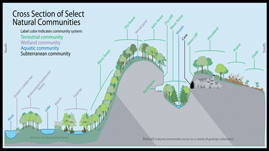Teachers' Domain - Digital Media for the Classroom and Professional Development
User: Preview


Natural communities are areas with similar plants, animals, and other organisms that exist because they share the need for certain environmental conditions. In this interactive adapted from Kentucky's Natural Heritage: An Illustrated Guide to Biodiversity, students can explore the four major kinds of natural communities and the organisms that make up each. They will learn about the characteristics of terrestrial, wetland, aquatic, and subterranean communities as well as specific members of each community.
Just as humans live and work together in communities, plants and animals live and work together in natural communities that contain similar plants, animals and other organisms. The four major kinds of natural communities are terrestrial, wetland, aquatic, and subterranean. Each one is defined by a number of factors such as plant species, vegetation assemblage (e.g. forest, marsh, etc.), climate, and other physical conditions.
Terrestrial communities are areas where flooding does not occur and the soil is easily drained. These communities are classified as forested and non-forested. Terrestrial forest communities can be broken down into further classifications depending on the typical soil saturation. Generally speaking, forests are areas that are thick with trees whose branches form a canopy. Even though there are a few evergreen forests in Kentucky, the state is made up of mostly deciduous forests where the trees have leaves that change color and fall off before the trees go dormant for the winter. Dry forests are another type of forest that can be found in areas where the soil is very well drained, such as areas with rocky soil. Typically, these forests are found along narrow ridgetops and slopes.
Wetland communities are areas that have shallow, standing water or highly saturated soil for prolonged periods of time (e.g. swamps and marshes). Because these areas occur in areas that do not drain easily, they are mostly found in lowlands like the floodplains for larger rivers. However some wetlands, such as vernal pools, can be found in depressions in uplands.
Aquatic communities are areas of running water such as rivers and streams, as well as standing water such as ponds, lakes, and wetlands. Communities of running water are known as lotic. The aquatic species found in these communities range from crayfish in shallow streams, to the gar, a large predator fish that lives in the deeper, slower moving rivers. Communities of standing water are known as lentic. Lentic communities provide a home for a variety of vegetation and insects along the top layer where light and oxygen are abundant and the temperatures are warmer. As the water gets deeper along the bottom where there is no light and oxygen is limited, vegetation does not exist but, several other species have found ways to adapt and thrive under these conditions.
The last of the major select natural communities is the subterranean community. As the name suggests, these are areas that are found under (sub) ground (terrain). The most researched subterranean community is the cave. Caves are formed in areas known as karst landscape. These are areas where natural acids in rain and groundwater gradually dissolve the rock below the land’s surface. Even though they start in areas above ground large enough to let in light and a variety of animals, including humans, caves eventually end in an area where no light is admitted and species are limited. Some species are so well adapted to the dark depths of the cave that they must remain in the subterranean community throughout their life cycle. For example, the cavefish does not have eyes and, therefore, could not survive in water above ground.
This is just a broad overview of four major natural community systems. Each one can be broken down further into several more natural communities that are found all over the world, based on the environmental conditions and particular species.
Use this interactive as an introduction to the major select natural communities. Have each student pick a specific system from one of the communities to research. Have them write a paper that includes the characteristics specific to that system, and the characteristics that make it a part of the specific community it belongs to.
 Loading Standards
Loading Standards